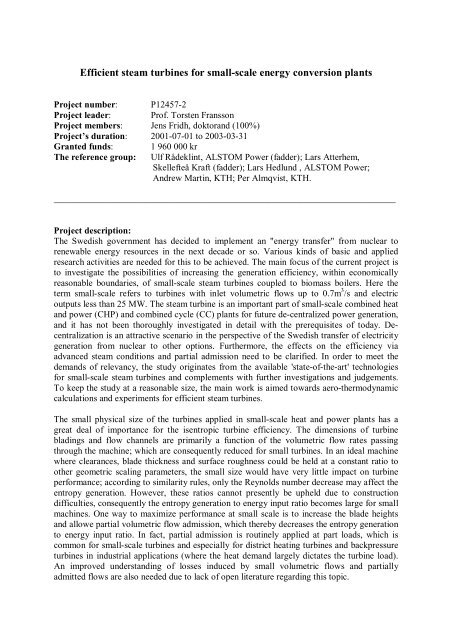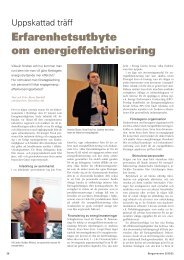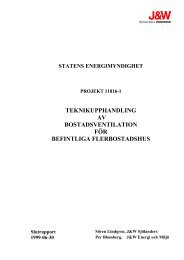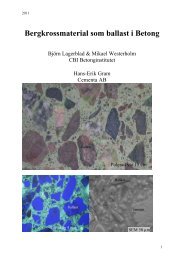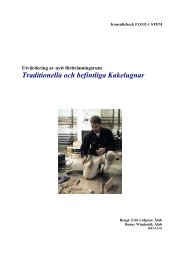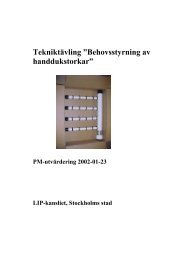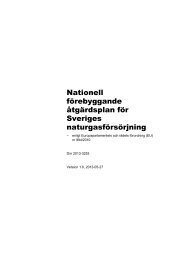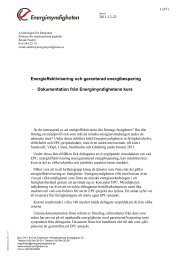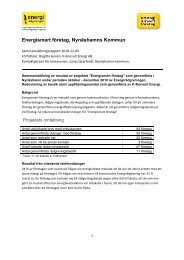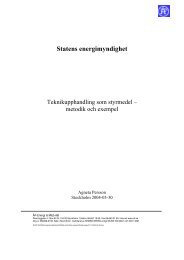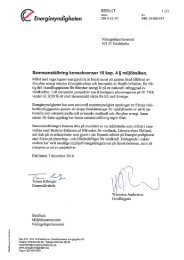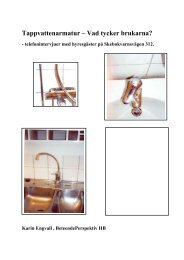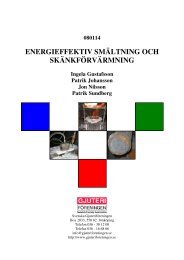ATAC i system - Energimyndigheten
ATAC i system - Energimyndigheten
ATAC i system - Energimyndigheten
You also want an ePaper? Increase the reach of your titles
YUMPU automatically turns print PDFs into web optimized ePapers that Google loves.
Efficient steam turbines for small-scale energy conversion plants<br />
Project number: P12457-2<br />
Project leader: Prof. Torsten Fransson<br />
Project members: Jens Fridh, doktorand (100%)<br />
Project’s duration: 2001-07-01 to 2003-03-31<br />
Granted funds: 1 960 000 kr<br />
The reference group: Ulf Rådeklint, ALSTOM Power (fadder); Lars Atterhem,<br />
Skellefteå Kraft (fadder); Lars Hedlund , ALSTOM Power;<br />
Andrew Martin, KTH; Per Almqvist, KTH.<br />
___________________________________________________________________________<br />
Project description:<br />
The Swedish government has decided to implement an "energy transfer" from nuclear to<br />
renewable energy resources in the next decade or so. Various kinds of basic and applied<br />
research activities are needed for this to be achieved. The main focus of the current project is<br />
to investigate the possibilities of increasing the generation efficiency, within economically<br />
reasonable boundaries, of small-scale steam turbines coupled to biomass boilers. Here the<br />
term small-scale refers to turbines with inlet volumetric flows up to 0.7m 3 /s and electric<br />
outputs less than 25 MW. The steam turbine is an important part of small-scale combined heat<br />
and power (CHP) and combined cycle (CC) plants for future de-centralized power generation,<br />
and it has not been thoroughly investigated in detail with the prerequisites of today. Decentralization<br />
is an attractive scenario in the perspective of the Swedish transfer of electricity<br />
generation from nuclear to other options. Furthermore, the effects on the efficiency via<br />
advanced steam conditions and partial admission need to be clarified. In order to meet the<br />
demands of relevancy, the study originates from the available 'state-of-the-art' technologies<br />
for small-scale steam turbines and complements with further investigations and judgements.<br />
To keep the study at a reasonable size, the main work is aimed towards aero-thermodynamic<br />
calculations and experiments for efficient steam turbines.<br />
The small physical size of the turbines applied in small-scale heat and power plants has a<br />
great deal of importance for the isentropic turbine efficiency. The dimensions of turbine<br />
bladings and flow channels are primarily a function of the volumetric flow rates passing<br />
through the machine; which are consequently reduced for small turbines. In an ideal machine<br />
where clearances, blade thickness and surface roughness could be held at a constant ratio to<br />
other geometric scaling parameters, the small size would have very little impact on turbine<br />
performance; according to similarity rules, only the Reynolds number decrease may affect the<br />
entropy generation. However, these ratios cannot presently be upheld due to construction<br />
difficulties, consequently the entropy generation to energy input ratio becomes large for small<br />
machines. One way to maximize performance at small scale is to increase the blade heights<br />
and allowe partial volumetric flow admission, which thereby decreases the entropy generation<br />
to energy input ratio. In fact, partial admission is routinely applied at part loads, which is<br />
common for small-scale turbines and especially for district heating turbines and backpressure<br />
turbines in industrial applications (where the heat demand largely dictates the turbine load).<br />
An improved understanding of losses induced by small volumetric flows and partially<br />
admitted flows are also needed due to lack of open literature regarding this topic.


